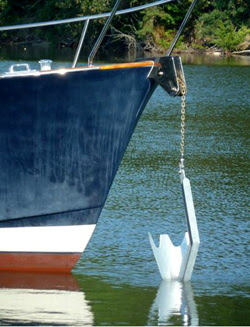REEDVILLE, VIRGINIA (USA) – For any anchor to perform to its maximum potential and design, it must be set properly according to the manufacturer’s directions, advises Steve Bedford of Max Marine Products, manufacturer of SuperMAX™ anchors.
“If in doubt, contact the manufacturer of your anchor regarding any specific setting procedures unique to your anchor,” Steve Bedford says.
There are, however, some fundamental techniques common to setting any recreational anchor and Steve shares them here.

Ground Tackle
A captain should have a thorough understanding of the anchor and ground tackle on the boat. Ground tackle consists of the anchor, shackles, swivels (if used), anchor chain and nylon anchor rode (if used). Deck hardware (cleats, etc.) that securely attach the chain or rode to the boat should be included as part of the ground tackle.
It is important to know the size, length, and strength of the chain and rode and insure that shackles and swivels are matched to the rode, chain and anchor specifications. Components that have an insufficient working load limit (WLL) will become the “weak link” and possibly fail. The WLL is the safe working limit rating before any permanent deformation (yield load limit) or breaking occur. The captain should feel comfortable and confident in the WLL limits from the manufacturer. Unfortunately, some manufacturers have a history of inaccurate calculations and the advertised WLL.
Anchorage Selection
There are several factors in determining an optimal anchoring location.
- Consider reliable reports from other boaters in identifying the seabed composition and holding ability.
- Use information on the chart of the area you intend to anchor in. If anchoring in seabeds with a reputation of reduced holding, special precautions must be made to insure confident and safe anchoring.
- Determine if the seabed is flat or sloped. Anchoring recommendations and directions are based on a flat seabed. A sloped seabed changes the angle of the rode to seabed floor which in turn effects the anchor’s ability to hold under stress of pull. A seabed slopping downward away from the bow of the vessel allows the captain to use a shorter rode. A seabed slopping upward away from the bow of the vessel requires the captain to use a longer rode.
- Check the tide table of the area. If anchoring during low tide, adjustments will need to be made in the scope length of the rode to accommodate high tide.
- Determine if there is sufficient depth, identify the location of any underwater obstructions, and the locations of any shoaling.
- Check the weather forecast for the location and time you intend to anchor. Determine the direction of the wind/weather.
- Determine the fetch, which is the unimpeded distance that is open to sea and wind.
Once you have decided that the location is acceptable to anchor, proceed to the most optimal location in the anchorage that will allow your vessel to swing unimpeded the at maximum scope.
If other vessels are anchored in the area, determine if the remaining space is sufficient to allow your vessel to swing unimpeded at maximum scope. If not, consider changing locations. The first anchored vessel has priority over a non-anchored vessel or any boats entering the location and anchoring. Caution should be taken if anchoring in front of another vessel. Allow plenty of space to back down away from your set location. Without knowing how much rode the anchored vessel has laid out, you could be backing down over top of the other vessel’s anchor.
If you determine the best spot to anchor is in front of an anchored vessel, move at least 2-3 times the length of maximum rode you intend to lay out ahead of the anchored vessel. Selecting a spot aft of another anchored vessel is usually a better choice. If anchoring beside a vessel, make sure the vessel is 2-3 times the length of maximum rode you intend to lay out away from your vessel.
Scope
Calculate the length of rode to lay out based on scope ratio. Scope is the ratio of anchor/rode length to the depth of the water including the height from the water surface to the anchor rode’s highest point going over the bow on the boat deck. For example, in water depth of 10 feet plus 5 feet from the surface of the water to the bow roller, the “actual anchoring depth” is 15 feet and therefore 75 feet of rode is needed for a 5:1 scope.
The depth of the water at high tide plus the height of the bow freeboard on the vessel to the water surface is your actual depth for anchoring. If you are anchoring during low tide, determine the height gain during high tide and use that depth rather than the low tide depth for your calculations. This avoids making adjustments in scope when high tide occurs.
The Anchoring Process
Point the vessel into the wind and/or current direction, bringing the vessel to a complete stop. Lower the anchor to rest completely on the seabed with a length of chain/rode that is slightly longer that the depth from bow roller to seabed floor. The boat should be drifting backward to avoid the anchor chain from dropping on the anchor. The anchor’s weight will allow it to settle into the seabed by its weight alone, unless you are anchoring is an extremely hard seabed.
Allowing the wind and/or current to begin to take the vessel backward, play out the rode to a 2-1/2 or 3 to 1 scope. Taking your time allows the anchor to dig into the seabed in the exact location it initially made contact with the sea floor. If you back down to quickly, before the anchor has a chance to settle into the seabed, the anchor may “skip” across the bottom.
Once the rode begins to straighten, the anchor is digging into the seabed. This next step is often used to help determine, early in the anchoring process, your anchor’s ability to set in the seabed. Secure the chain/ rode. This action protects the windlass. With the transmission in reverse, slightly increase the RPMs of the engine to pull the chain or rode tight. This is not the actual “set.” Continue to slowly increase the RPMs slightly. This technique allows the user to determine if the anchor’s fluke(s) have indeed engaged the seabed without laying out a great deal of rode and then finding the anchor is not catching the seabed. In a crowded or limited anchorage, finding this out with a 2.5:1 or 3:1 rode requires less action to start over than if the captain has played out a 7:1 scope. You may have to move rather quickly retrieving a greater amount of rode and anchor while also staying away from other anchored vessels.
The tension applied with a 40 horse power engine on a sailboat is different than what is created with twin 400 hp diesels on a motor vessel. Practice will help determine the proper RPM level on your vessel for this process. Reduce the RPM and return to neutral. Lay out about a 5:1 scope and repeat the process, again, backing down slowly. As the chain straightens again, secure the chain or nylon rode and increase the RPMs until the anchor set causes the boat to a stop again. At this final set position, apply more RPMs. Practice provides confidence in the exact RPM level used in the final set and for what duration. A slow anchoring process allows the anchor to dig deep into the seabed as pressure is applied. Sudden jerks before the final set could compromise the anchor’s position in the seabed.
Once firmly set in the seabed, lay out the desired rode length. Determine anchor rode scope considering tidal changes, potential wind shifts or increase in velocity, proximity to other boats and land structures, seabed topography, seabed substrate, and predicted weather conditions. Under normal conditions the recommended scope ratios of most anchors range from 5:1 to 7:1. Many anchoring experts routinely lay out greater scope lengths up to 10:1. Check the manufacturer’s recommendations and check with other users of this anchor for their recommendations based on experience.
Completing The Anchoring Process
When anchoring with an “all chain” rode, attach a nylon line to absorb “chain” shock when the chain is pulled tight to its maximum length. This process avoids transfer of that shock to the windlass. The nylon line, properly sized for the chain, anchor size, and boat size will stretch as it becomes taunt and eliminate the sudden jerk of the chain and the annoying noise that accompanies that action. Secure the nylon line to the chain either with a mechanical device such as a chain hook or with a rolling hitch knot. This attachment should be approximately at the water surface. Allow the chain to slack from the nylon line attachment on the chain to the deck attachment.
When the anchoring process is complete, note the landmarks off the port, starboard and stern of your vessel. Monitor the landmarks to determine if the anchor is dragging. Continue to monitor your position after current, tide, or wind shifts and establish new landmarks in the new orientation.
Consider the use of an anchor sensor device on a GPS or a smart phone application that produces an alarm informing the user that the vessel has moved beyond a calculated radius from the original anchor set location. These require the user to “mark” the location where with anchor first dropped to the seabed. From that point, the user determines the radius distance based on the amount if anchor rode played out. If the program senses a greater distance from the anchor set point than programmed, an alarm will sound.
For more information about anchoring and also SuperMAX anchors, visit the SuperMAX anchors web site, email [email protected] or call 1+855.943.8262.
-0-
Max Marine Products – 1023 Blackwells Wharf Road – Burgess, VA 22432 USA
